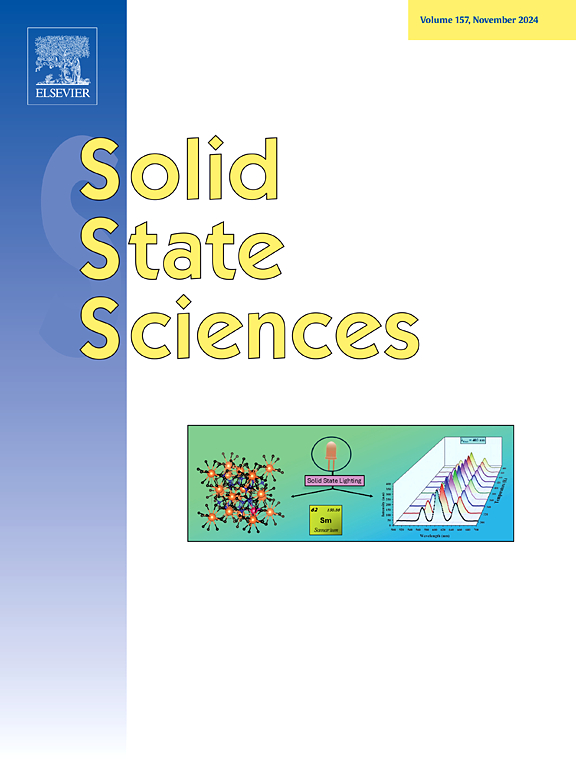聚乙烯醇水凝胶固定化MnO2-BiOCl光催化剂在可见光下可重复光降解罗丹明B和布洛芬的调控
IF 3.4
3区 化学
Q2 CHEMISTRY, INORGANIC & NUCLEAR
引用次数: 0
摘要
水中药物和有机染料的存在对人类健康和环境都构成了重大关切。虽然光催化剂提供了一种有效的污染物降解手段而不产生二次废物,但它们通常受到电荷重组和颗粒尺寸小的限制,无法大规模实际使用。本研究将BiOCl化学沉积在二氧化锰上,并固定在聚乙烯醇水凝胶薄膜中,在可见光下光降解罗丹明B和布洛芬。通过扫描和透射电镜图像证实,该板状BiOCl成功生长在mno2纳米花之间。能量色散x射线分析和傅里叶变换红外光谱结果证实了BiOCl和mno2的化学性质,x射线衍射图证实了BiOCl和mno2的结晶度。优化BiOCl的负载,与MnO2的比例为2:1,得到了具有高光催化活性的PVA薄膜。罗丹明和布洛芬分别在60 min和90 min内降解99%和97%。即使经过五次循环,催化剂对RhB和布洛芬的效率仍保持在80%以上。降解主要由MnO2和BiOCl复合材料产生的•O2−和e−驱动。这项研究强调了biocl - mno2 /PVA水凝胶复合材料在可持续、可重复使用和高效的水处理应用中的潜力。本文章由计算机程序翻译,如有差异,请以英文原文为准。

Modulation of MnO2-BiOCl photocatalyst immobilized in polyvinyl alcohol hydrogel for reusable photodegradation of Rhodamine B and Ibuprofen under visible light
The presence of pharmaceutical drugs and organic dyes in water poses significant concerns for both human health and the environment. While photocatalysts offer an effective means of pollutant degradation without generating secondary waste, they are commonly limited by charge recombination and small particle size for large-scale practical use. In this study, BiOCl was chemically deposited on MnO2 and immobilization in the polyvinyl alcohol hydrogel thin films for the photodegradation of Rhodamine B and Ibuprofen under visible light. The plate-like BiOCl successfully grown between nanoflowers of MnO₂, as proven by scanning and transmission electron microscopy images. Energy dispersive X-ray analysis and Fourier-transform infrared spectroscopy results affirmed the chemical characteristics of BiOCl and MnO₂, while X-ray diffraction patterns confirmed the crystallinity of BiOCl and MnO₂. Optimizing the BiOCl loading, 2:1 in ratio with MnO2 yielded a PVA thin film with high photocatalytic activity. 99 % of Rhodamine and 97 % of Ibuprofen were degraded in 60 min and 90 min respectively. Even after five recycles, the catalyst maintained over 80 % efficiency for RhB and 70 % for Ibuprofen. The degradation was primarily driven by •O2− and e− generated by the MnO2 and BiOCl composite. This study highlights the potential of BiOCl-MnO₂/PVA hydrogel composites for sustainable, reusable, and efficient water treatment applications.
求助全文
通过发布文献求助,成功后即可免费获取论文全文。
去求助
来源期刊

Solid State Sciences
化学-无机化学与核化学
CiteScore
6.60
自引率
2.90%
发文量
214
审稿时长
27 days
期刊介绍:
Solid State Sciences is the journal for researchers from the broad solid state chemistry and physics community. It publishes key articles on all aspects of solid state synthesis, structure-property relationships, theory and functionalities, in relation with experiments.
Key topics for stand-alone papers and special issues:
-Novel ways of synthesis, inorganic functional materials, including porous and glassy materials, hybrid organic-inorganic compounds and nanomaterials
-Physical properties, emphasizing but not limited to the electrical, magnetical and optical features
-Materials related to information technology and energy and environmental sciences.
The journal publishes feature articles from experts in the field upon invitation.
Solid State Sciences - your gateway to energy-related materials.
 求助内容:
求助内容: 应助结果提醒方式:
应助结果提醒方式:


